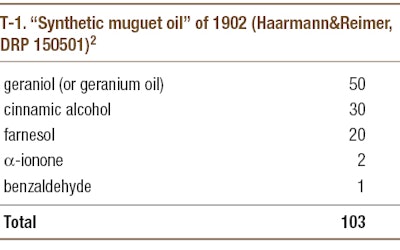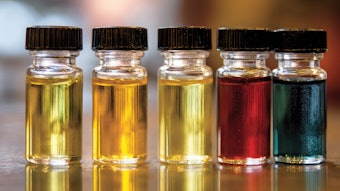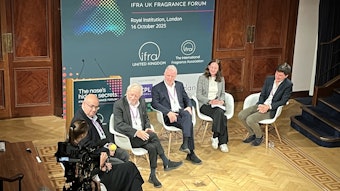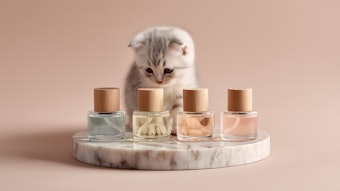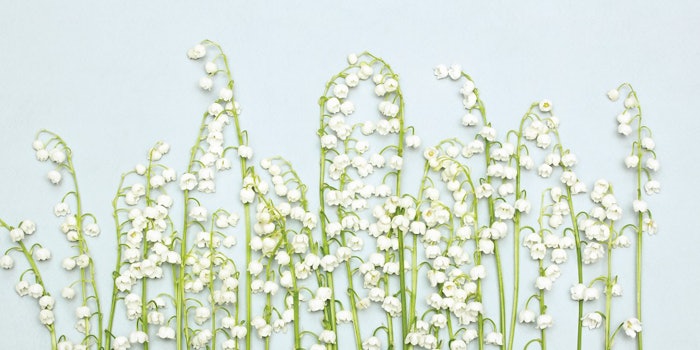
Muguet Odorants – History of a Central Note
While other essential oils and absolutes of flowers such as rose and jasmine are expensive, there does not even exist a commercial essential oil for lily-of-the-valley (“muguet” in French) flowers. Due to the delicate equilibrium of white floral notes around indole, rosy odorants such as citronellol and nerol, balsamic notes such as cinnamic alcohol and benzyl benzoate, with the linden-blossom note of farnesol and the green, fresh-cut grass aspects of (3Z)-hex-3-en-1-ol (leaf alcohol), even supercritical CO2 extraction destroys the uniquely balanced, most characteristic odor of the inflorescences of Convallaria majalis L. Although dihydrofarnesal1 can be regarded as a constituent of the headspace of muguet flowers that combines all aspects of this natural scent in one compound, it is a trace component only. There simply is no principle natural odorant for lily-of-the-valley flowers.
The “synthetic muguet oil” that is detailed in T-1 and was patented in 19022 illustrates the difficulties in composing a credible lily-of-the-valley scent without specific muguet odorants. Today it is still educational to smell this simplistic attempt on a complex natural scent. However, things changed dramatically when hydroxycitronellal (1) surfaced, which was first introduced to perfumery by the German company Knoll & Co. in 1905 (F-1). Distinguished by its content in the undesired minty-rosy menthoglycol (Geranodyl) and the minty-herbaceous isopulegol, soon different qualities for use in perfumery appeared on the market such as Laurine (Givaudan, 1906)—named after the Givaudan chemist Laurier, who optimized the process—and Cyclosia (Firmenich, 1908).3 As hydroxycitronellal (1) features all aspects of the muguet odor in one molecule only, it was readily adapted in perfumery. The complex odor profile of lily-of-the-valley flowers that was so difficult to compose from other perfumery ingredients now became a big advantage of hydroxycitronellal (1) which integrated all sorts of floral notes, rendering it possible to compose big fantasy bouquets.
Fully in line with this perfumistic function, the delicate sweet-floral muguet note of hydroxycitronellal (1) celebrated its first success in fine fragrances with approximately 2.5% in Quelques Fleurs (Houbigant, 1912) by Robert Bienaimé, where it added a central muguet theme that tied together the rose, jasmine, ylang-ylang, lilac and violet accords into a floral potpourri. The most characteristic use of 1 was probably by Edmond Roudnitska in his groundbreaking muguet soliflore Diorissimo (Dior, 1956), where he used around 10% of hydroxycitronellal (1). Even before Quelques Fleurs, we also found close to 10% of hydroxycitronellal (1) in Nivea Crème (Beiersdorf, 1911), in an archetypical accord with lavender, hesperidic and cinnamic notes, rose, geranium, ionones and ylang-ylang. Although hydroxycitronellal is most pleasing hedonically, its rather high odor threshold (th) of 4.8 ng/L air makes it not very efficient in compositions. Especially, 1 does not satisfy when it comes to providing thickness, texture and creaminess to a formula, not to mention the use limitations of today due to its skin sensitization properties.4
The next big milestone in the muguet family was the discovery of cyclamen aldehyde (2), and again Givaudan was at the forefront. Gustave Louis Blanc (1872–1927) of the University of Paris had discovered that 3-(4’-isopropylphenyl)-2-methylpropanal (2) possessed a powerful floral odor reminiscent of the cyclamen flower of the Savoy Alps. Blanc was curious about its perfumistic value, and showed 2 to Léon Givaudan (1875–1936), who immediately recognized the potential of this compound, which was first named ‘Aldehyde B’ in honor of Professor Blanc.5 Several process improvements finally led to the quality of cyclamen aldehyde (2) that we know today, which at 2.5 ng/L air is twice as powerful as hydroxycitronellal (1) – too strong to handle for some perfumers of those days who found their formulas difficult to adapt. For that reason Givaudan incorporated it first in a number of specialty bases such as Cyclamen 1155, Muguet 16, Amarate and Oeillet 1246, the success of which then made perfumers crave for pure cyclamen aldehyde (2).
Yet, Marion Scott Carpenter and William M. Easter, Jr., of Givaudan Delawanna continued to work hard on lowering the cost of cyclamen aldehyde (2) and on enhancing its potency. The straightforward approach was to replace the para-isopropyl group on the aromatic ring of 2 by a more bulky tert-butyl group, which indeed lowered the odor detection threshold by a factor of 5 to 0.45 ng/L air. First submitted to olfactory evaluation in June 1946, the similarity of Lilialb (3) with hydroxycitronellal (1) and cyclamen aldehyde (2) that were found potent enough, did not generate any interest from the evaluating perfumers. That’s how one of the most important and successful odorants in the history of perfumery got rated “sans intérêt olfactive appréciable” (translation: “without any noticeable olfactory benefit”) at first (F-2).
Yet, the Lilial history shows that olfactory performance prevails in the end, and Carpenter kept insisting on re-evaluations. After 10 years, he convinced the perfumers, and the Lilial patent was filed in June, 1956.6 Since then, Lilial experienced a triumphal success in perfumery, making it for quite a while the most important Givaudan product in terms of volume and value.
Moreover, Julian Dorsky and William M. Easter, Jr., of Givaudan also synthesized the nor-derivative 4 of Lilial (3), which was initially introduced into perfumery as Isolilial (4).7 Although being more diffusive, Isolilial is with a threshold of 0.4 ng/L air comparable in strength to Lilial (3). When the patent expired, the former Quest began to produce and market Isolilial as Bourgeonalc (4). Being promoted mainly in functional perfumery for its stability in aggressive media, such as antiperspirants, Bourgeonal(4) gained good fame in the late 1990’s. However, compared to Lilial (3) with its universal application range, the volumes of Bourgeonal (4) remained generally over 50 times smaller.
The next milestone was the hydroxyaldehyde Lyrald (5) which Robert W. Teegarden and Leonard Steinbach of IFF discovered in 1960.8 Lyral (5) possesses an odor threshold of 0.1 ng/L air, and due to its long lastingness became a huge success in perfumery, especially in fine fragrances, up to the point where its massive usage led to sensitization issues becoming one of the most abundant fragrance allergens. It has to be labeled on the package as “hydroxyisohexyl 3-cycohexene carboxaldehyde” (HICC) and the SCCS recommended in 2011 to discontinue the use of Lyral (5).9
Installing the γ,δ-unsaturated linear aldehyde motif of Bourgeonal (4) on the dicylopentadiene dimer skeleton as an inexpensive bulky group then led Harmannus Boelens and colleagues in Naarden to discover Dupicale (6).10 With an odor threshold of 0.36 ng/L air, it is comparable in strength to Bourgeonal (4), but 6 is even more substantive than Lyral (5) in fabric care. Due to these excellent features of Dupical (6), perfumers accept a higher price.
The conformationally more flexible linear structure 8 was discovered as a powerful alternative to Lyral (5).11 Introduced in 2014 by Givaudan, Mahonialf was named after Mahonia japonica, for its diffusive muguet smell. With an odor threshold of 0.025 ng/L it is four times more powerful than Lyral (5), but imparts a similar floral density in perfumery. Olfactorily, it offers a replacement of Lyral (5) at lower doses, bringing a new muguet character at a normal dosage, and a magnolia theme when overdosed. In comparison with hydroxycitronellal (1), the odor threshold in the hydroxy aldehyde family with its natural muguet note could thus be lowered by an impressive factor of almost 200 in the past 110 years, with consequently less exposure and sensitization. Introduced by a juicy pear, Mahonial (8) had its debut in Missoni (Missoni, 2015) by Quentin Bisch. Additionally, Mahonial (8) freshened up the classical rose–patchouli accord in the chypre Valentino Donna (Valentino, 2015) by Sonia Constant and Antoine Maisondieu. It is also prominently recognizable in La Femme Prada and L’Homme Prada (Prada, 2016) by Daniela Andrier at around 2% and 4%, respectively, and in Le Male Essence de Parfum (Jean Paul Gaultier, 2016) by Quentin Bisch.
Yet even before Mahonial, an alternative muguet aldehyde had been discovered by Alan J. Chalk at Givaudan’s Clifton facility in June 1987 and was patented in 1988:Florhydralg (7).12 Chalk had discovered in 1,3-diprop-1’-en-2-ylbenzene (DIPEB) an interesting and attractively priced starting material, and subjected it to sequential hydroformylation and hydrogenation experiments, thereby discovering a powerful fresh-floral natural lily-of-the-valley odorant with green hyacinth facets six times more potent even than Lilial (3) in terms of detection threshold. While earlier qualities had plastic-type off-notes, these could be associated to a by-product formed, which then could be eliminated by process optimization.
While Florhydral (7), in combination with other ingredients, is able to replace Lilial (3) to a certain extent, the challenge to find an olfactorily closer and better performing Lilial (3) replacer still remained a clear business need for the F&F industry; and was consequently given priority on the agenda of nearly every research center in the F&F industry. To this end, in 2015, Firmenich introduced Mimosalh (9) as a patented captive,13 which in formulation together with muguet alcohols such as Mayoli can replace Lilial (3) quite well. With a value of 0.35 ng/L, it is also comparable to Lilial (3) in terms of odor threshold. It has a pronounced green side in the direction of syringa aldehyde, which might be explained structurally by the para-methyl phenyl moiety of compound 9. This unit mimics the tert-butyl substituent of Lilial (3) shifting its bulk group vinylogously into the structural tail of the compound.
Herein, we report Givaudan’s solution in the chase for the perfect Lilial replacement: Nympheal (10), which was patented in 201414 and introduced as a captive ingredient in 2016. It had its debut at 0.5% in Woman in Gold (By Kilian, 2017) by Calice Becker, where it brings fluidity and aura to a powdery sweet rose accord around Petaliaj and Rosyfoliak in a floral chypre context with Akigalawoodl for structure and contrast. The name “Nympheal” was inspired by Claude Monet’s (1840–1926) series of paintings featuring water lilies, “nymphéas” in French. Offered to the French State by the artist as a ‘monument to peace’ in response to the horrors of World War I, Les Nymphéas were installed according to Monet’s plan at the Musée de l’Orangerie in Paris and opened to the public on May 16, 1927. One of the largest paintings of the 20th century, the masterpiece encompasses almost 100 meters, providing as the artist said an “illusion of an endless whole, of a wave with no horizon and no shore.”Of the many different water lilies, one of the most beautiful is certainly the white nenuphar, Nymphea alba L. (vide infra on the insert with the perfume samples) with its typical aquatic floral odor reminiscent of lily-of-the-valley flowers and water melon. Nympheal (10) features a floral muguet and cyclamen note similar to Lilial (3), with additional fruity, aquatic and linden blossom facets. While similar to Lilial (3) in character, Nympheal (10) is much more powerful both in terms of odor threshold and in its function in perfume formulation.
The Success Story of Lilial
But before we enter into greater detail regarding the discovery of Nympheal (10), let us first look at the features of Lilial (3) that made it so successful in perfumery. As already mentioned, the ingredient is very cost-efficient throughout all stages of a perfume, especially in the dry-down – a most important feature in fabric and personal care. Moreover, it is truly an odorant that is almost equally popular in all segments. Lilial (3) has a floral transparency close to Hedionem, the freshness and cleanliness of the linear aldehydes, even going into slightly marine and water-melon fruitiness, but all that on a floral body of Dimetoln- and linalool-like dimensions. It has a universal white floralcy, and combines very well with rose, violet and jasmine odorants of all sorts, even integrates green facets up to violet leaves and galbanum. Thus, Lilial (3) provides a universal floral heart in the context of structure, thickness and creaminess. One can see muguet aldehydes with Lilial (3) as their most prominent and archetypal representative for the heart of a fragrance, just as musks are the foundation and fixation of perfumes in the fond. Perhaps the best example for this effect is White Musk (The Body Shop, 1981), in which some 6% of Lilial is juxtaposed to almost 60% of ethylene brassylate to give this classical clean white musk effect. Lilial (3) imparts perfumistic sensuality and softness in the heart of a composition, thereby epitomizing a feeling and appeal the consumer expects from a perfume, not only in fine fragrances but in every segment from laundry care to soaps and shampoos. In short, Lilial (3) is universal, which is always a good recipe for success.
The consumption of Lilial (3) in the F&F industry is estimated to be around 15,000 tons per annum. Even today it is still intensively used despite the regulatory threat.15 In any case, it is the most important muguet odorant in terms of consumption as well as value, much before Lyral (5), cyclamen aldehyde (2), hydroxycitronellal (1), Florhydral (7), Bourgeonal (4) and Dupicalo (6).
In the context of cost vs. performance, the synthesis of Lilial was industrially very attractive from the start: Marion Scott Carpenter commenced from the Lewis-acid catalyzed Friedel–Crafts alkylation of benzene (11) to furnish tert-butyl benzene (12), followed by chloromethylenation with subsequent oxidation to the formyl group, aldol condensation of the resulting 4-(tert-butyl)-benzaldehyde with propanal and concluding catalytic hydrogenation as delineated in F-3. Igor Scriabine of Rhone-Poulenc16 introduced the side chain via a Lewis-acid catalyzed reaction of benzene 12 with 2-methylprop-2-ene-1,1-diyl diacetate. Saponification of the resulting enol acetate 15 then furnished Lilial (3) in attractive yields.
Though again relying on aldol condensation and hydrogenation in the concluding steps, the electrochemical approach of BASF by oxidation of tert-butyl toluene (17) is even more efficient than the Scriabine process. Due to the use of acidic electrolytes, dialkyl acetals are formed in the electrochemical dehydrogenation step. These intermediates can be purified from undesired side products, prior to hydrolysis to 18.17,18
Lilial Use Restrictions
Lilial is a sensational ingredient, but it does have one liability: studies have shown that it can trigger testicular effects in rats, linked to the in vivo formation of a toxic metabolite, namely a benzoic acid derivative tBBA (21, F-4). In October 2012, Lilial (3) was self-classified in the registry of submitted Harmonized Classification and Labelling intentions as CMR 2 (fertility).15 The perfume industry continues to use Lilial in accordance with the current legislation and the IFRA standards. Nonetheless, taking into account the regulatory threat and the fact that some consumer product companies proactively removed Lilial (3) from perfume creation, we kicked off an intensive Lilial (3) replacement program to address the emerging need for a new and sustainable muguet note.
Discovery of Nympheal
In the replacement of Lilial, there are two major considerations: On one hand, olfactory properties as close as possible to Lilial are required, and on the other, the molecule should be free of structural elements that could cause reprotoxicty issues. In the latter endeavor, we were greatly assisted by having access to a rapid and robust assay that simulates the in-vivo side chain degradation, developed in-house by the group of Andreas Natsch and Heike Laue.19
With regard to the safety aspects of our studies, the toxicity issue of Lilial was believed to be the result of the side chain degradation (see F-4) to the acid 21, which corresponds to a formal β-oxidation of carboxylic acids. With this consideration in mind, our discovery approach was to try to find appealing new Lilial-like muguet odorants that were not susceptible to the formation of such potentially reprotoxic benzoic acid derivatives. More specifically, we explored:
(a) The synthesis of relatively unexplored phenyl butanals, such as compound 22, and
(b) the introduction of cyclohexenyl derivatives, such as 24 with Lilial-like substitution patterns, hoping that such non-aromatic moieties would effectively imitate the odor of benchmark dihydrocinnamic aldehydes (F-5).20
However, neither the phenyl butanals nor the cyclohexenyl derivatives provided a solution to the reproductive toxicological issues, which became evident when phenyl butanals, such as compound 22, were exposed to hepatocyte cells: one β-oxidation cycle should result in phenyl acetic acid 23, not in benzoic acids 21. Surprisingly, however, tBBA 21 was also detected in the assay.19 This puzzling finding revealed that the side chain degradation of dihydrocinnamic aldehydes to benzoic acids could not be explained merely by a β-oxidation of the side chain, but rather by a more complex and un-foreseen mechanism.
The other surprising discovery is depicted in F-5(b): Cyclohexenyl derivative 24 astonishingly first metabolized to acid 25, and then unexpectedly aromatized to the potentially toxic benzoic acid derivative 26! Therefore, non-aromatic cyclohexenyl derivatives of Lilial may not necessarily constitute safe solutions when it comes to avoiding a CMR 2 risk.
Beat Winter of Firmenich had reported on the olfactory properties of ortho-methyl substituted compounds such as 31 and 32 (F-6) in a study of analogues of Lilial.21,22 However, the molecules were never commercially developed, and also in our own evaluations these compounds were not fulfilling the performance and hedonics criteria for replacing Lilial in formulation. Still further, the compounds also carried with them the entirely reasonable burden that they would present a reproductive toxicity challenge given the presence of the propanal side-chain. Nevertheless, we proceeded to synthesize a series of compounds set forth in F-6 in order to better understand their structure–odor relationships. The series of compounds can be accessed by the synthetic sequence shown in F-6, which proceeds via the bromination of meta-substituted benzene derivatives 27, followed by Grignard reaction to benzaldehydes 29, and introduction of the propanal side chain by Müller–Cunradi–Piero reaction and subsequent hydrogenation.23 Indeed, in the series of compounds 31–37 depicted in F-6, Nympheal (10) had the lowest measured odor threshold combined with a most pleasant Lilial-like odor profile, enriched by the desired water lily and soft linden blossom nuances. Branching in the alpha-position of the phenyl ring (compounds 32 and 33) had greener, slightly rubbery connotations, and even longer chain derivatives 35 and 36 were less performing than Nympheal (10). The unsaturated derivative 3424 showed quite similar olfactory properties to Nympheal, but was slightly less watery and lily-of-the-valley-like. Regioisomer 37, possessing a more Florhydral-like constitution, conveyed a pleasant natural but greener scent and besides had a considerably higher odor threshold.
Compound 10 was the closest to Lilial in odor character and was also the most intense having an odor threshold of 0.021 ng/L air. We ran the compound through the assay19to confirm its anticipated reproductive toxicity issues and were astonished to discover, however, that no benzoic acid derivative was observed within the detection limit of the assay. Apparently, the metabolic pathway leading to the corresponding benzoic acid derivative was being disrupted. Our only explanation for this discovery is that the ortho-methyl group somehow sterically shields the molecule from the metabolic degradation of the propanal side chain. A complete shut-down of this metabolic pathway by steric means was entirely unpredictable. One could almost say that the bespoke ortho-methyl group in Nympheal(10) is somehow magic as it imparts a most pleasant, natural muguet, water lily-like scent of exceptional performance, and simultaneously eliminates any reproductive toxicity risk.
An Olfactophore Model For Muguet Aldehydes
Although the discovery of Nympheal was a pleasant surprise, it is instructive to look at Nympheal and other muguet aldehydes by using olfactophore modelling tools. The Discovery Studio software package25 can provide insights into the optimization of olfactory performance by depicting which areas should denote hydrophobic substituents for van-der-Waals interaction on the olfactory receptor(s) relative to the most polar functional group (=osmophore, in this case a hydrogen-bond acceptor), and where there would be excluded volumes, in which substituents have a detrimental effect on the odor. The olfactophore model in F-7 shows our result based on the threshold data of a training set of 57 muguet aldehydes. The activity was calculated as a molar detection threshold from the individual odor thresholds of a sensory panel. Most interestingly, while devised only from muguet aldehydes, two of the three hydrophobes, namely I and II correspond almost exactly to the hydrophobes I and II of the muguet olfactophore model26,27 generated in 1999 from bifunctional muguet odorants such as hydroxycitronellal (1) and Lyral (5), combining the so-called Pelzer fragments28 in one model. So it could very well be that the hydroxy and the aromatic aldehydes bind to the same set of olfactory receptors. The model could predict the odor thresholds with a correlation of 77%. Even though the calculated threshold of 0.16 ng/L for Nympheal (10) is almost eight times higher than the experimentally measured one (0.021 ng/L air), the fits are generally good in terms of relative tendencies.
Perfumery Example Lilial vs. Nympheal
Although in terms of odor threshold Nympheal (10) is about 20 times more potent, in formulation the effect levels out and Nympheal (10) is dosed about 5–10 times less than Lilial (3). In composition, both Nympheal (10) and Mahonial (8) drive perfumery evolution towards high-impact odorants despite being safe in use. This is best illustrated in the Odor Value Map delineated in F-8, which is a standard working tool of Givaudan.29 The Odor Value (OV) is a measure of overall strength and potency, and is defined as the dimensionless quotient of the vapor pressure and its threshold concentration, thus indicating how many times the odor threshold concentration is contained in the saturated headspace. Multiplied with the parts of a certain compound in a formula, the OV provides a useful estimate of its sensory contribution to the overall fragrance. In the OV Map in F-8 the muguet aldehydes from the timeline F-1 are compared. The odor thresholds are marked on the abscissa, while the vapor pressure is given on the ordinate. The OV as a function of both parameters are then indicated by diagonal lines.
Following the timeline numbers from hydroxycitronellal (1) to cyclamen aldehyde (2) to Lilial (3) and so on till Nympheal (10), we see a clear trend towards lower thresholds and more substantivity, though the latter is less clear. Yet, Lyral (5) is still the least volatile muguet odorant. We also see clearly three different performance families, the first one ranging from OV 1,000–10,000 comprising only hydroxycitronellal (1), while the one from OV 10,000–100,000 contains cyclamen aldehyde (2), Lilial (3), Bourgeonal (4), Lyral (5) and Mimosal (9), and the third family from OV 100,000–1,000,000 includes Dupical (6), Florhydral (7), Mahonial (8) and Nympheal (10). Looking at the vapor pressure axis and independent from their odor characters, both Nympheal (10) and Mimosal (9) are closely related to Lilial (3) in their evaporation profiles.
But words and diagrams can only go so far, let’s now smell Nympheal (10) versus Lilial (3) in comparison in the demo composition in T-2, which is contained in the samples on the insert depicting lily-of-the-valley flowers for Lilial (3) and the white nenuphar, Nymphea alba L. for Nympheal (10). The accord of the formula T-2 is somewhat inspired by the ancient Givaudan base Muguet 16 but interprets the classical muguet accord less figuratively, more expressionistic, and draws new dynamism from the white nenuphar theme with its additional fruity-aquatic watermelon facets specifically highlighted by the aldehydic marine, floral melon facets of Calypsone that are underscored by Melozone. In the top, citral dimethyl acetal, with a bit of agrestic hesperidic help of Dimetol, prepares the nose for this watery freshness that is contrasted by green dashes from (3Z)-hex-3-enol. Rhodinol, Givescone and α-amyl cinnamic aldehyde provide a general floral background for Nympheal (10) and Lilial (3) to shine and provide thickness, structure and creaminess to the muguet accord. White floralcy is enhanced by jasmine absolute with some boost from indolene and cis-jasmone, and the water lily–muguet accord is then fixated in a sweet musky way by 28% of Serenolidewith powdery-lactonic accents from Vertofix Cœur and γ-undecalactone.
Given its high potency, almost 4% of Nympheal (10) is a massive overdose in this fresh and clean context, and in comparison with Lilial (3) the composition with 10 has much more dynamic punch and radiance than with 3. In addition, the green facets of Nympheal (10) activate the (3Z)-hex-3-enol contrast more, deepen it, and render the composition more aquatic and feminine. With the same amount of Lilial, (3) the fresh floral character of the composition is very similar, though the muguet accord with Lilial (3) appears flatter and slightly sweeter. Creaminess, fullness and silkiness of the composition with Nympheal (10), as well as its transparency and olfactory capacity are however superior to Lilial (3), and especially in an aquatic context, the watery linden blossom facets of Nympheal (10) offer new possibilities for creative perfumistic expression.
In other words, Nympheal(10) is not only the perfect choice for Lilial (3) replacement in perfumery, but independently a wonderfully diffusive new and safe ingredient in the fundamentally important floral muguet odor family.
Acknowledgments
We are indebted to Dr. Roman Kaiser and Dr. Olivier David (Université de Versailles Saint-Quentin) for photographs and pictures, to Dr. Agnes Bombrun for constructive criticism and discussions, to Joos Kiener for extraction of OV data, to Jacques Membrez for contributing the Lilial evaluation sheet (F-2) and to Dr. Kimberly Geoghegan for proof-reading the manuscript.

